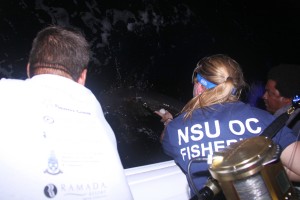NSU Newsroom
SharkBytes
Horizons
This version of NSU News has been archived as of February 28, 2019. To search through archived articles, visit nova.edu/search. To access the new version of NSU News, visit news.nova.edu.
This version of SharkBytes has been archived as of February 28, 2019. To search through archived articles, visit nova.edu/search. To access the new version of SharkBytes, visit sharkbytes.nova.edu.
Survival of the Swordfish
Nova Southeastern University graduate student investigates the survival rates of juvenile swordfish under federal catch and release law
HOLLYWOOD Fla. — Jenny Fenton is passionate about swordfish. After all, they are a top ocean predator whose survival is vital to balancing the ocean’s ecosystem as well as being an important food source.
But years of overfishing in the Florida Straits — where America’s swordfish nursery is located — have depleted their population. So much so that longline fishing gear is now outlawed in the Straits and juvenile swordfish caught there measuring 47 inches or less must be released. Longline gear uses up to 1,000 hooks strung on a single line to catch large quantities of fish.
Fenton, a graduate student in marine biology at Nova Southeastern University’s Oceanographic Center, decided to make her passion a research project. During the last two years, she has been analyzing the survival rates of juvenile swordfish caught by fishermen using rod and reel and buoy gear. Her research is the first study of its kind.
Of the 20 satellite tags she plans to put on the captured fish, data from 16 have been analyzed. Five of the fish have died within a day, while nine survived without problems.
Her findings are important because the federal government is considering a measure that would allow recreational fishermen to catch swordfish for commercial use. If that happens, the number of juvenile swordfish caught could skyrocket in the Florida Straits, which goes through South Florida. Most of the adult swordfish found in waters throughout the Eastern Seaboard were born in the Florida Straits.
Swordfish were once abundant in South Florida. However, longline fishing gear dramatically depleted the species. In response, federal authorities banned this type of gear in the Florida Straits in 2001.
In 2003, a limited swordfish buoy gear fishing method developed in the Straits that uses only about 15 single hooks and float combinations, near the ocean’s surface. However, NSU Oceanographic Center research Scientist David Kerstetter, Ph.D., Fenton’s graduate advisor, conducted a study from 2007 to 2010 that found a few juvenile swordfish deaths from the buoy gear.
More than a decade after the longline ban, local swordfish stocks have returned to healthier levels. However, catch-and-release fishing has resulted in some dead swordfish. A potential decision to allow recreational fishermen to sell their catch commercially would put more juvenile swordfish at risk.
Fenton, whose study is sponsored by the NOAA Fisheries Service, will share her data with the federal agency. Then it will be up to resource managers to decide whether allowing swordfish anglers to sell their catch commercially is worth the fishing pressure it would put on their nursery grounds.
“This has been a fascinating project working with such an important species to both recreational fishing and the commercial fishing industry,” Fenton said. “I hope my data will be used to sustain healthy populations of swordfish for future generations to enjoy, as well as balancing the ecosystem.”
Fenton, who is using this project as her master’s thesis, said the four remaining tags will be deployed soon.
###
About Nova Southeastern University’s Oceanographic Center: A world leader in marine biological research with focus on coral reef science and shark conservation, Nova Southeastern University’s Oceanographic Center has been at the forefront of graduate and undergraduate marine science education and oceanographic research for over 48 years. Students, scientists, faculty and staff come to the Center from all corners of the globe, with the common goal of learning from the ocean’s living classrooms — in one of the most diverse ecosystems known to man. http://www.nova.edu/ocean/
About Nova Southeastern University: Situated on 300 beautiful acres in Davie, Florida, Nova Southeastern University is a dynamic fully accredited research institution dedicated to providing high-quality educational programs at all levels. NSU is the eighth largest not-for-profit independent institution nationally with more than 28,000 students. NSU awards associate’s, bachelor’s, master’s, specialist, doctoral and first-professional degrees in a wide range of fields. Classified as a research university with “high research activity” by the Carnegie Foundation for the Advancement of Teaching, NSU is one of only 37 universities nationwide to also be awarded Carnegie’s Community Engagement Classification. www.nova.edu
Media Contact:
Ken Ma, MBA, NSU Office of Public Affairs
954-262-5408 (office), 954-621-7961 (cell), ken.ma@nova.edu
